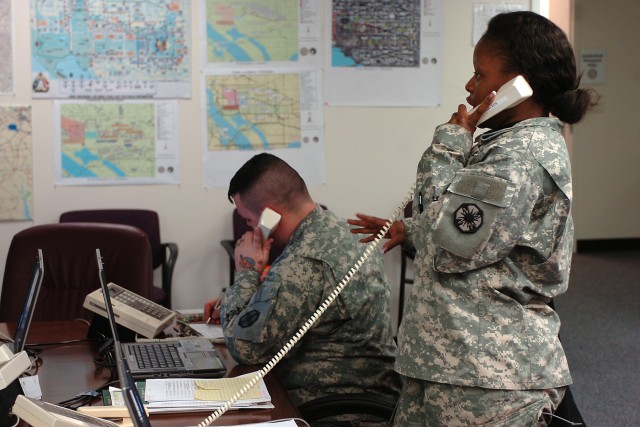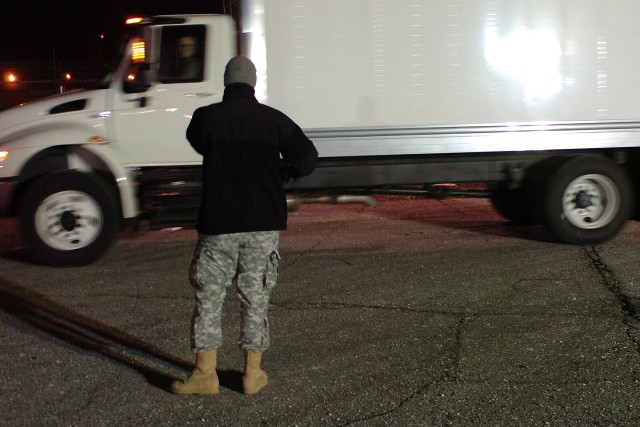WASHINGTON - While much of the country was focused on the inauguration ceremony and parade for the nation's 44th President Jan. 20, a group of 25 Soldiers from the Fort Hood, Texas, based 49th Transportation Battalion, 15th Sustainment Brigade, 13th Sustainment Command (Expeditionary), were working behind the scenes to ensure things went smooth.
The Soldiers were responsible for proving movement control and support to military units participating in the inauguration ceremony as well as the Presidential Parade following the ceremony, said Sgt. 1st Class Paul Meredith, the noncommissioned officer in charge of the movement control center.
With more than 2 million people descending on the nation's capital for the historic inauguration, traffic in and around the city was sure to be heavier than normal, and the 49th's Soldiers ensured ceremony and parade participants got to where they needed to be when they needed to be there.
Meredith explained that some of the Soldiers operated a phone bank, a place for the participants to call if they ran into trouble on the road, be it heavy traffic, a flat tire or a breakdown.
The movement control Soldiers would first identify the impact on the event, then work to provide the participant assistance to get them back on schedule, whether it be guiding them through traffic, which was monitored through the city's traffic cameras, or sending another bus to pick up the passengers and continue on their way, Meredith, a Jacksonville, Fla., native, said.
"Transportation was the sole issue to make or break this historic occasion," Meredith said, and due to the sheer number of people attending and participating in the inauguration, the coordination and tracking of the important moves became that much more important.
All of the scheduled movements were tracked in a movement table, which included information on exact times and locations for each element as they entered and exited Washington, said 2nd Lt. LaCandice Johnson, a shift officer in charge with the 49th.
The Soldiers worked with representatives from each of the participating units, police departments and the involved Departments of Transportations to monitor road closures, so the Soldiers had the most up to date information if they needed to reroute a participant, Johnson said.
I'm glad to a part of the ceremony, but I wish we had been here since the planning started in October," said Meredith.
Even if the 49th's Soldiers aren't on display at the Capitol, they know they have an impact on the ceremony, Meredith said.
"We know the importance of doing our job - we see it every day," he said. "The transportation motto is 'Nothing happens until something moves.'"
Sgt. Anthony Burroughs, one of the movement control center NCOs, explained that his job was to track all of the buses into and out of Washington for the event. Burroughs, a Grove Hill, Ala., native, said he only received one call from a participant with a flat tire. He coordinated for a recovery team to be sent out, and the vehicle was back on the road within 30 minutes.
Like many of the Soldiers on the mission, Burroughs took great pride in being a part of the ceremony.
"Our goal was accomplished once the parade started," he said, adding that it was heart-filling to know he was a part of the reason President Barack Obama was able to start the parade when he was ready.
The 49th's Soldiers also managed several dispersed nodes around the city where the Soldiers "staged" the vehicles in the early morning hours of Jan. 20, said Sgt. 1st Class Justin Patterson, the NCOIC of the node at Naval Support Activity Anacostia, in Washington.
Patterson explained that his Soldiers were responsible for getting an accurate count of vehicles and passengers, and reporting the actual departure time from the staging area to the Movement Control Center.
According to Patterson, the staging area at Anacostia had more than 120 vehicles pass through, carrying nearly 1,000 passengers.
The transportation Soldiers played a key role in the inauguration, ensuring that the most watched show in the world went off without a hitch.
Meredith said, "It's very special to be a part of this historic occasion."




Social Sharing